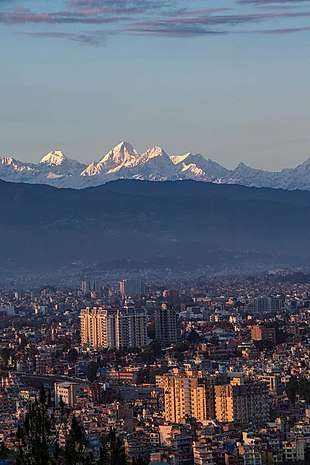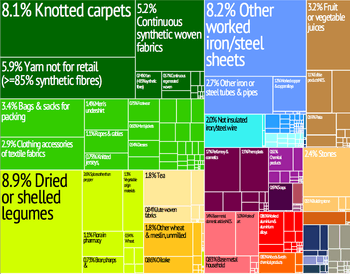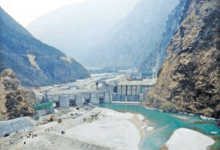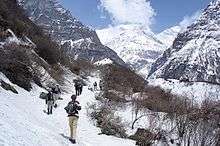Economy of Nepal
Economic development in Nepal has been complicated and affected by the constant change in political scenarios which has ranged from monarchy to being ruled by the Communist party in 2019. An isolated, agrarian society until the mid-20th century, Nepal entered the modern era in 1951 without schools, hospitals, roads, telecommunications, electric power, industry, or civil service. The country has, however, made progress toward sustainable economic growth since the 1950s and opened the country to economic liberalization leading to economic growth and improvement in living standards than compared to the past. The biggest challenges faced by the country in achieving higher economic development are the frequent changes in political leadership as well as corruption.
 Kathmandu, the financial centre of Nepal | |
| Currency | Nepalese rupee (NPR, रू) |
|---|---|
| 16 July - 15 July | |
Trade organizations | WTO, SCO and SAFTA |
Country group | |
| Statistics | |
| Population | |
| GDP | |
GDP growth |
|
GDP per capita | |
GDP by sector |
|
| 6.1% (2020 est.)[4] | |
Population below poverty line | |
| 32.8 medium (2010)[9] | |
Labour force | |
Labour force by occupation |
|
| Unemployment | 3% (2017 est.)[6] |
Main industries | tourism, carpets, textiles; small rice, jute, sugar, and oilseed mills; cigarettes, cement and brick production[6] |
| External | |
| Exports | |
Export goods | clothing, pulses, carpets, textiles, juice, jute goods[6] |
Main export partners |
|
| Imports | |
Import goods | petroleum products, machinery and equipment, gold, electrical goods, medicine[6] |
Main import partners | |
FDI stock | |
Gross external debt | |
| Public finances | |
| −0.1% (of GDP) (2017 est.)[6] | |
| Revenues | 5.925 billion (2017 est.)[6] |
| Expenses | 5.945 billion (2017 est.)[6] |
Foreign reserves | |
Nepal has used a series of five-year plans in an attempt to make progress in economic development. It completed its ninth economic development plan in 2002; its currency has been made convertible, and 17 state enterprises have been privatised. Foreign aid to Nepal accounts for more than half of the development budget. Government priorities over the years have been the development of transportation and communication facilities, agriculture, and industry. Since 1975, improved government administration and rural development efforts have been emphasised.
Agriculture remains Nepal's principal economic activity, employing about 65% of the population and providing 31.7% of GDP. Only about 20% of the total area is cultivable; another 40.7% is forested (i.e., covered by shrubs, pastureland and forest); most of the rest is mountainous. Fruits and vegetables (apples, pears, tomatoes, various salads, peach, nectarine, potatoes), as well as rice and wheat are the main food crops. The lowland Terai region produces an agricultural surplus, part of which supplies the food-deficient hill areas.
GDP is heavily dependent on remittances (9.1%) of foreign workers. Subsequently, economic development in social services and infrastructure in Nepal has not made dramatic progress. A countrywide primary education system is under development, and Tribhuvan University has several campuses. Although eradication efforts continue, malaria had been controlled in the fertile but previously uninhabitable Terai region in the south. Kathmandu is linked to India and nearby hill regions by road and an expanding highway network. The capital was almost out of fuel and transport of supplies caused by a crippling general strike in southern Nepal on 17 February 2008.[15]
Major towns are connected to the capital by telephone and domestic air services. The export-oriented carpet and garment industries have grown rapidly in recent years and together now account for approximately 70% of merchandise exports.
The Cost of Living Index in Nepal is comparatively lower than many countries but not the least. The quality of life has declined to much less desirous value in recent years.[16] Nepal was ranked 54th worst of 81 ranked countries (those with GHI > 5.0) on the Global Hunger Index in 2011, between Cambodia and Togo. Nepal's current score of 19.5 is better than in 2010 (20.0) and much improved than its score of 27.5 in 1990.[17]
Foreign investments and taxation
Huge numbers of Small Foreign Investments come to Nepal via the Non Resident Nepali, who are investing in shopping malls, plazas, real estate, tourism, etc. Nepal has a huge capacity for hydroelectricity. Accordingly, a large number of foreign companies are in line, but political instability has stopped the process at the same time as it is growing on its own. Nepal has entered into agreements for avoidance of double taxation (all in credit method) with 10 countries (PSRD) since 2000. Similarly, it has Investment protection agreements with 5 countries (PSRD) since 1983. In 2014, Nepal restricted the Foreign aid by setting a minimum limit for foreign grants, soft and commercial loans from its development partners.[18]
Imports and exports

Nepal's merchandise trade balance has improved somewhat since 2000 with the growth of the carpet and garment industries. In the fiscal year 2000–2001, exports posted a greater increase (14%) than imports (4.5%), helping bring the trade deficit down by 4% from the previous year to $749 million. Recently, the European Union has become the largest buyer of ready-made garments; fruits and vegetables (mostly apples, pears, tomatoes, various salads, peach, nectarine, potatoes, rice) from Nepal. Exports to the EU accounted for 46.13 percent of the country's garment exports.[19]
The annual monsoon rain, or lack of it, strongly influences economic growth. From 1996 to 1999, real GDP growth averaged less than 4%. The growth rate recovered in 1999, rising to 6% before slipping slightly in 2001 to 5.5%.
Strong export performance, including earnings from tourism, and external aid have helped improve the overall balance of payments and increase international reserves. Nepal receives substantial amounts of external assistance from the United Kingdom,[20][21][22] the United States, Japan, Germany, and the Scandinavian countries.
Several multilateral organisations such as the World Bank, the Asian Development Bank, and the UN Development Programme also provide assistance. In June 1998, Nepal submitted its memorandum on a foreign trade regime to the World Trade Organization and in May 2000 began direct negotiations on its accession.
Resources
Progress has been made in exploiting Nepal's natural resources, tourism and hydroelectricity. With eight of the world's 10 highest mountain peaks, including Mount Everest at 8,848 m. In the early 1990s, one large public sector project and a number of private projects were planned; some have been completed. The most significant private sector financed hydroelectric projects currently in operation are the Khimti Khola (60 MW) and the Bhote Koshi Project (36 MW). The project is still undergoing and has dependency on China, India and Japan to take the further steps.

Nepal has 83,000 MW of theoretical and 42,133 MW of technically/financially viable hydroelectric potential, however the total installed capacity, at present, is mere 1095 MW.[23]
The environmental impact of Nepal's hydroelectric Own calendar (Bikram Sambat) New year in mid- April projects has been limited by the fact that most are "run-of-the-river" with only one storage project undertaken to date. The largest hydroelectric plant under consideration is the West Seti Dam (750 MW) storage project dedicated to exports to be built by the private sector. Negotiations with India for a power purchase agreement have been underway for several years, but agreement on pricing and financing remains a problem. Currently demand for electricity is increasing at 8-10% a year whereas Nepal's option to have agreement with India will make this fulfilment against demand.
Population pressure on natural resources is increasing. Over-population is already straining the "carrying capacity" of the middle hill areas, particularly the Kathmandu Valley, resulting in the depletion of forest cover for crops, fuel, and fodder and contributing to erosion and flooding. Although steep mountain terrain makes exploitation difficult, mineral surveys have found small deposits of limestone, magnesite, zinc, copper, iron, mica, lead, and cobalt.
The development of hydroelectric power projects also cause some tension with local indigenous groups, recently empowered by Nepal's ratification of ILO Convention 169.[24]
Macro-economic trend
This is a chart of trend of gross domestic product of Nepal at market prices estimated by the International Monetary Fund and EconStats with figures in millions of Nepali Rupees.
| Year | Gross domestic product |
|---|---|
| 1960 | 3,870 |
| 1965 | 5,602 |
| 1970 | 8,768 |
| 1975 | 16,571 |
| 1980 | 23,350 |
| 1985 | 46,586 |
| 1990 | 103,415 |
| 1995 | 219,174 |
| 2000 | 379,488 |
The following table shows the main economic indicators in 1980–2018.[25]
| Year | 1980 | 1985 | 1990 | 1995 | 2000 | 2005 | 2006 | 2007 | 2008 | 2009 | 2010 | 2011 | 2012 | 2013 | 2014 | 2015 | 2016 | 2017 | 2018 |
|---|---|---|---|---|---|---|---|---|---|---|---|---|---|---|---|---|---|---|---|
| GDP in $ (PPP) |
6.02 Bln. | 9.86 Bln. | 14.39 Bln. | 20.90 Bln. | 28.75 Bln. | 38.45 Bln. | 40.97 Bln. | 43.49 Bln. | 47.05 Bln. | 49.56 Bln. | 52.58 Bln. | 55.50 Bln. | 59.23 Bln. | 62.67 Bln. | 67.62 Bln. | 70.62 Bln. | 71.82 Bln. | 78.59 Bln. | 84.37 Bln. |
| GDP per capita in $ (PPP) |
404 | 590 | 767 | 977 | 1,211 | 1,500 | 1,579 | 1,659 | 1,777 | 1,853 | 1,946 | 2,031 | 2,142 | 2,239 | 2,387 | 2,464 | 2,477 | 2,679 | 2,842 |
| GDP growth (real) |
−2.3 % | 6.1 % | 14.4 % | 3.5 % | 6.1 % | 3.5 % | 3.4 % | 3.4 % | 6.1 % | 4.5 % | 4.8 % | 3.4 % | 4.8 % | 4.1 % | 6.0 % | 3.3 % | 0.6 % | 8.2 % | 6.7 % |
| Inflation (in Percent) |
9.8 % | 4.1 % | 8.9 % | 7.7 % | 3.4 % | 4.5 % | 8.0 % | 6.2 % | 6.7 % | 12.6 % | 9.6 % | 9.6 % | 8.3 % | 9.9 % | 9.0 % | 7.2 % | 9.9 % | 4.5 % | 4.2 % |
| Gov. debt (Pct. of GDP) |
... | ... | ... | ... | 58 % | 51 % | 49 % | 43 % | 42 % | 39 % | 34 % | 32 % | 34 % | 32 % | 28 % | 25 % | 27 % | 27 % | 27.4 % |
Statistics
GDP: purchasing power parity - $84.37 Billion (2018 est.)[26]
GDP - real growth rate: 21.77% (2017)
GDP - per capita: purchasing power parity (current international $) - $2700 (2017 est.)
GDP - composition by sector:
agriculture: 17%
industry: 13.5%
services: 60.5% (2017 est.)
tourism: 9%
Population below poverty line: 21.6% (2017/2018)[27]
Household income or consumption by percentage share:
lowest 10%: 3.2%
highest 10%: 29.8% (1995–96)
Inflation rate (consumer prices): 4.5% (2017)
Labour force: 4 million (2016 est.) [Citation needed.]
Labor force - by occupation: agriculture 19%, services 69%, industry 12% (2014 est.)
Unemployment rate: 3.2% (2017 est.)
Budget:
revenues: $5.954 billion
expenditures: $5.974 billion, including capital expenditures of $NA (2017 est.)
Industries: tourism, carpet, textile; small rice, jute, sugar, and oilseed mills; cigarette; cement and brick production
Industrial production growth rate: 10.9% (2017 est.):
Electricity - production: 41,083 GWh (2017)
Electricity - production by source:
fossil fuel: 7.5%
hydro: 91.5%
nuclear: 0.3%
other: 0.7% (2001)
Available energy:6257.73 GWh (2017) NEA Hydro:2290.78 GWh (2014) NEA Thermal:9.56 GWh (2014) purchase (total):2331.17 GWh (2014) India (purchase):2175.04 GWh (2017) Nepal (IPP):1258.94 GWh (2014)
Electricity - consumption: 4,776.53 GWh (2017)
Electricity - exports: 856 GWh (2001) Electricity - imports: 12 GWh (2001)
Oil - production: 0 barrels per day (0 m3/d) (2001 est.)
Oil - consumption: 1,600 barrels per day (250 m3/d) 2001
Agriculture - products: Fruits and vegetables, mostly: apples, pears, tomatoes, peaches, nectarines, potatoes, rice, maize, wheat, sugarcane, root crops, milk, and buffalo meat.
Exports: $1.34 billion f.o.b., but does not include unrecorded border trade with India (2017 est.)
Exports - commodities: carpets, clothing, leather goods, jute goods, grain
Exports - partners: India 56.6%, US 11.5%, Turkey 4% (2016 est.)
Imports: $1.03 billion f.o.b. (2017 est.)
Imports - commodities: gold, machinery and equipment, petroleum products, electrical goods, medicine
Imports - partners: India 70.1%, China 10.3%, UAE 2.6%, Singapore 2.1%, Saudi Arabia 1.2%. (2016 est.)
Debt - external: $5.948 billion (2017 est.)
Economic aid - recipient: $424 million (FY 00/01)
Currency: 1 Nepali rupee (NPR) = 100 paisa
Fiscal year: 16 July - 15 July
References
- "World Economic Outlook Database, April 2019". IMF.org. International Monetary Fund. Retrieved 29 September 2019.
- "World Bank Country and Lending Groups". datahelpdesk.worldbank.org. World Bank. Retrieved 1 July 2020.
- "Population, total". World Bank. Retrieved 10 November 2019.
- "World Economic Outlook Database, October 2019". IMF.org. International Monetary Fund. Retrieved 20 October 2019.
- "Global Economic Prospects, June 2020". openknowledge.worldbank.org. World Bank. p. 98. Retrieved 24 June 2020.
- "The World Factbook". CIA.gov. Central Intelligence Agency. Retrieved 25 January 2019.
- "Poverty headcount ratio at national poverty lines (% of population) - Nepal". data.worldbank.org. World Bank. Retrieved 18 January 2020.
- "Poverty headcount ratio at $3.20 a day (2011 PPP) (% of population) - Nepal". data.worldbank.org. World Bank. Retrieved 1 July 2020.
- "GINI index (World Bank estimate)". data.worldbank.org. World Bank. Retrieved 25 January 2019.
- "Human Development Index (HDI)". hdr.undp.org. HDRO (Human Development Report Office) United Nations Development Programme. Retrieved 11 December 2019.
- "Inequality-adjusted HDI (IHDI)". hdr.undp.org. UNDP. Retrieved 22 May 2020.
- "Labor force, total". World Bank. Retrieved 2 November 2019.
- "Employment to population ratio, 15+, total (%) (national estimate)". World Bank. Retrieved 14 September 2019.
- "Ease of Doing Business in Nepal". Doingbusiness.org. Retrieved 24 October 2019.
- Kathmandu nearly out of fuel, Nepal says. CNN. 17 February 2008. Retrieved 2008-04-13.
- Cost of Living Index in Nepal - Statistics & Graphs of Nepalese Citizen's Economic Power. Retrieved 10 January 2014.
- IFPRI/ Concern/ Welthungerhilfe: 2011 Global Hunger Index The challenge of hunger: Taming price spikes and excessive food price volatility. Bonn, Washington D. C., Dublin. October 2011.
- "Nepal puts a minimum amount limit on foreign aid and loans". IANS. news.biharprabha.com. Retrieved 3 July 2014.
- "EU as Nepal's largest exporter". ktm2day. Retrieved 11 October 2011.
- "UK should cut aid to Nepal if "endemic" corruption persists: report". Reuters. 27 March 2015. Retrieved 16 May 2015.
- "DFID's bilateral programme in Nepal". The International Development Committee of the House of Commons. 27 March 2015. Retrieved 17 May 2015.
- "A Conversation with Departing Nepal Chief of the UK Aid Agency". United We Blog! for a Democratic Nepal. 15 June 2013. Retrieved 16 May 2015.
- "Nepali Political parties criticize Indian Hydel Power proposal". IANS. news.biharprabha.com. Retrieved 20 July 2014.
- Jones, Peris: When the lights go out. Hydroelectric power and indigenous rights in Nepal Archived 30 April 2011 at the Wayback Machine. NIBR International Blog 11.03.10
- "Report for Selected Countries and Subjects". Retrieved 30 August 2018.
- http://www.indexmundi.com/nepal/economy_profile.html
- https://mof.gov.np/uploads/document/file/for%20web_Economic%20Survey%202075%20Full%20Final%20for%20WEB%20_20180914091500.pdf
![]()
External links
- Global Economic Prospects: Growth Prospects for South Asia The World Bank, 13 December 2006
- World Bank Summary Trade Statistics Nepal
